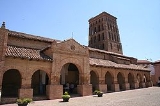
Sahagún, Spain
Encyclopedia
Sahagún is a town in the province of León
, Spain
. It is the main town of the Leonese section of the Tierra de Campos
comarca.
Sahagún is notable for containing some of the earliest examples of the mudéjar
style of architecture. It lies on the Way of St. James
.
The initial town arose due to the adjacent Benedictine
monastery consecrated to the saints Facundus and Primitivus
. The name Sahagún putatively derives from an abbreviation and variation on the name San Fagun ("Saint Facundus").
de Asturias, and reached its greatest splendor during the reign of Alfonso VI of Castile
. On November 25, 1085, this latter king promulgated the edicts known as the Fuero de Sahagún, which gave a number of privileges to the Monastery and town, fomenting its growth. The king favoured the Cluniac order and the monastery was known as the "Spanish Cluny
".
Friction often erupted into disputes between the townsfolk and the monastery in the mid-12th century, as recorded in the Crónicas anónimas de Sahagún
. The monastery was very important on the pilgrimage route to Santiago de Compostela
, and in the 14th century housed a University (see also List of early modern universities in Europe). In the 19th century, the monastery was disbanded and the structure nearly completely razed.
León (province)
León is a province of northwestern Spain, in the northwestern part of the autonomous community of Castile and León.About one quarter of its population of 500,200 lives in the capital, León. The weather is cold and dry during the winter....
, Spain
Spain
Spain , officially the Kingdom of Spain languages]] under the European Charter for Regional or Minority Languages. In each of these, Spain's official name is as follows:;;;;;;), is a country and member state of the European Union located in southwestern Europe on the Iberian Peninsula...
. It is the main town of the Leonese section of the Tierra de Campos
Tierra de Campos
Tierra de Campos is a large historical region or greater comarca that straddles the provinces of León, Zamora, Valladolid and Palencia, in Castile and León, Spain...
comarca.
Sahagún is notable for containing some of the earliest examples of the mudéjar
Mudéjar
Mudéjar is the name given to individual Moors or Muslims of Al-Andalus who remained in Iberia after the Christian Reconquista but were not converted to Christianity...
style of architecture. It lies on the Way of St. James
Way of St. James
The Way of St. James or St. James' Way is the pilgrimage route to the Cathedral of Santiago de Compostela in Galicia in northwestern Spain, where tradition has it that the remains of the apostle Saint James are buried....
.
The initial town arose due to the adjacent Benedictine
Benedictine
Benedictine refers to the spirituality and consecrated life in accordance with the Rule of St Benedict, written by Benedict of Nursia in the sixth century for the cenobitic communities he founded in central Italy. The most notable of these is Monte Cassino, the first monastery founded by Benedict...
monastery consecrated to the saints Facundus and Primitivus
Facundus and Primitivus
Saints Facundus and Primitivus are venerated as Christian martyrs. According to tradition, they were Christian natives of León who were tortured and then beheaded on the banks of the River Cea...
. The name Sahagún putatively derives from an abbreviation and variation on the name San Fagun ("Saint Facundus").
Villages
Arenillas de Valderaduey, Celada de Cea, Galleguillos de Campos, Joara, Riosequillo, Sahagún, San Martín de la Cueza, San Pedro de las Dueñas, Sotillo de Cea, Villalebrín and Villalmán.Monastery
The monastery acquired importance during the reign of Alfonso IIIAlfonso III of León
Alfonso III , called the Great, was the king of León, Galicia and Asturias from 866 until his death. He was the son and successor of Ordoño I. In later sources he is the earliest to be called "Emperor of Spain"...
de Asturias, and reached its greatest splendor during the reign of Alfonso VI of Castile
Alfonso VI of Castile
Alfonso VI , nicknamed the Brave or the Valiant, was King of León from 1065, King of Castile and de facto King of Galicia from 1072, and self-proclaimed "Emperor of all Spain". After the conquest of Toledo he was also self-proclaimed victoriosissimo rege in Toleto, et in Hispania et Gallecia...
. On November 25, 1085, this latter king promulgated the edicts known as the Fuero de Sahagún, which gave a number of privileges to the Monastery and town, fomenting its growth. The king favoured the Cluniac order and the monastery was known as the "Spanish Cluny
Cluny
Cluny or Clungy is a commune in the Saône-et-Loire department in the region of Bourgogne in eastern France. It is 20 km northwest of Mâcon.The town grew up around the Benedictine Cluny Abbey, founded by Duke William I of Aquitaine in 910...
".
Friction often erupted into disputes between the townsfolk and the monastery in the mid-12th century, as recorded in the Crónicas anónimas de Sahagún
Crónicas anónimas de Sahagún
The Crónicas anónimas de Sahagún are two short chronicles composed by the monks of Sahagún two centuries apart. They survive only in sixteenth-century Spanish translations....
. The monastery was very important on the pilgrimage route to Santiago de Compostela
Santiago de Compostela
Santiago de Compostela is the capital of the autonomous community of Galicia, Spain.The city's Cathedral is the destination today, as it has been throughout history, of the important 9th century medieval pilgrimage route, the Way of St. James...
, and in the 14th century housed a University (see also List of early modern universities in Europe). In the 19th century, the monastery was disbanded and the structure nearly completely razed.

